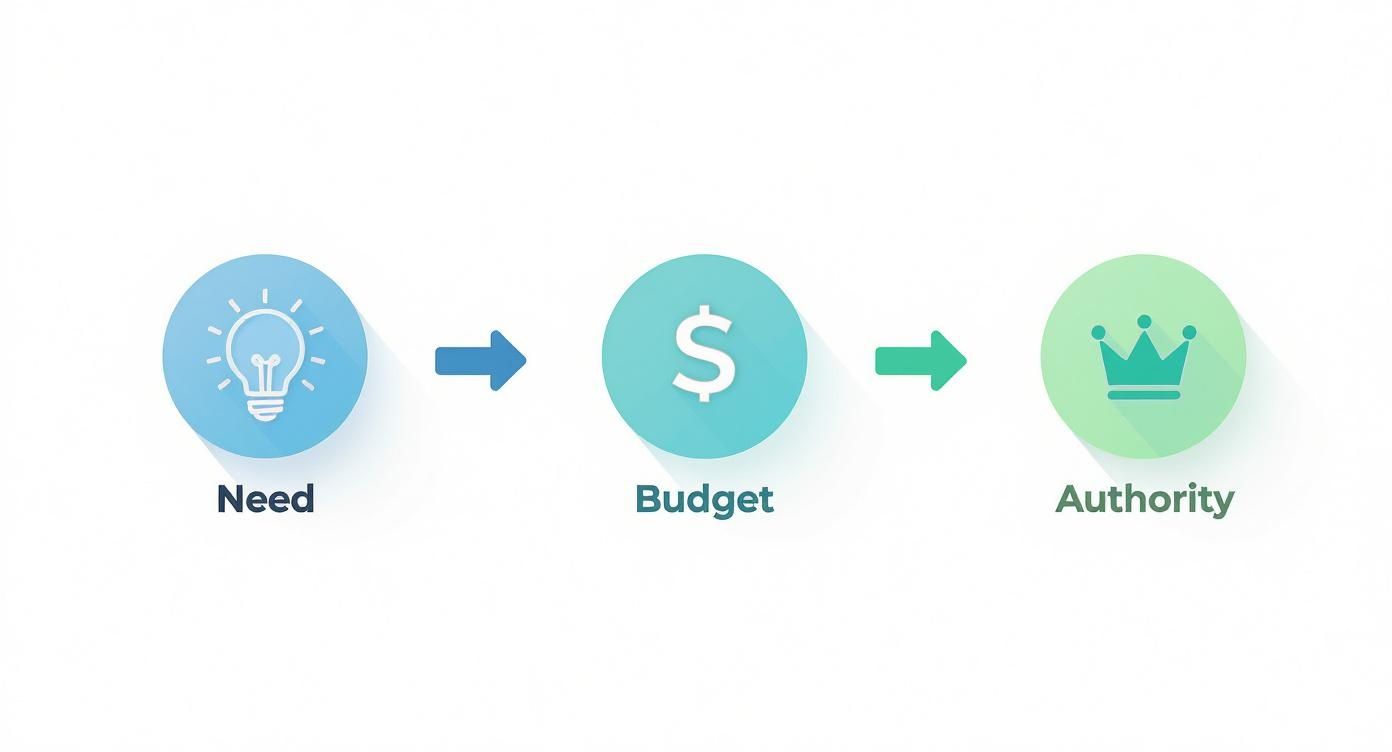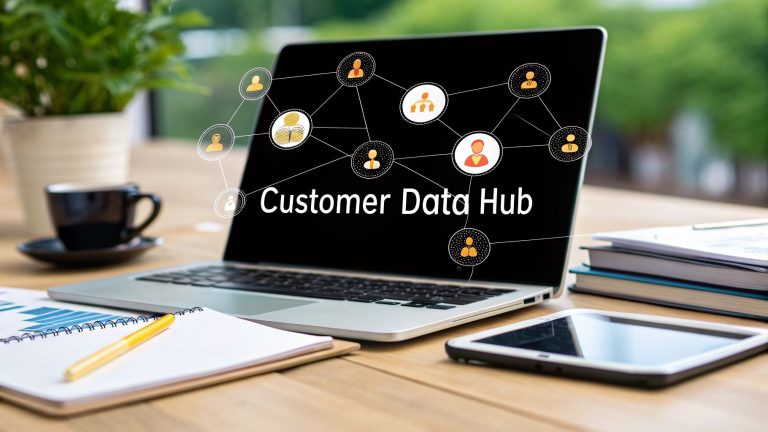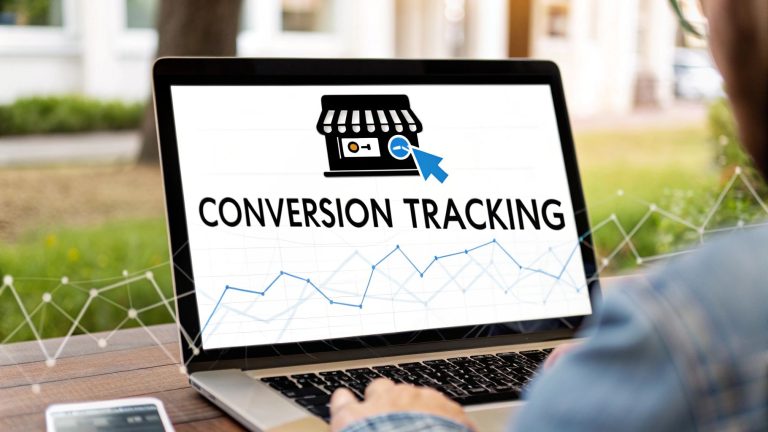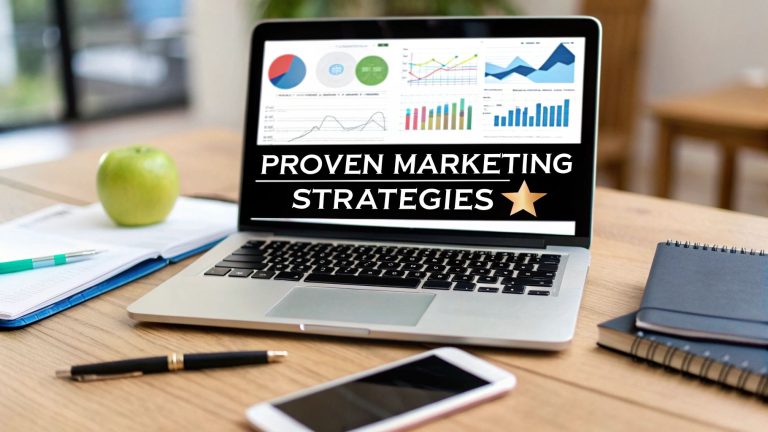Discover what is a sales qualified lead and why it matters
Let's be honest, not all leads are created equal. Some are just window shopping, while others are ready to talk business. A Sales Qualified Lead (SQL) falls firmly into that second category—they're the prospects who have moved past general curiosity and are showing real signs they're ready for a one-on-one sales chat.
They've been checked out by marketing and given the green light by sales, confirming they have a genuine, near-term need to buy. It's the moment a prospect puts their hand up and says, "Okay, I'm serious."
Decoding the Sales Qualified Lead
Picture your sales funnel as a series of gates. A visitor might become a lead by downloading an ebook. They could even become a Marketing Qualified Lead (MQL) after attending a webinar. But an SQL is someone who’s passed through that final gate right before the sales team steps in. They’ve shown both interest and a high probability of becoming a paying customer.
This isn't just about changing a label in your CRM; it's a critical handoff. The prospect is basically saying they have a problem and think your solution could be the fix. This is where marketing passes the baton to sales, turning a nurtured lead into a live opportunity. Getting this handoff right is the secret to an efficient sales machine.
Core Characteristics of an SQL
An SQL isn't defined by a single click or download. It’s a combination of who they are and what they’ve done. To avoid wasting time, smart sales teams use a clear framework to make sure a lead is truly "qualified" before they start calling.
This process just confirms the lead checks all the right boxes. In fact, companies with a well-defined process for identifying SQLs see up to a 30% higher conversion rate from lead to customer. That's a huge difference. You can discover more insights about lead qualification on piwik.pro if you want to dig deeper.
An SQL is the bridge between marketing's broad outreach and sales' focused engagement. Getting this definition right means your sales team spends its time talking to people who are genuinely prepared to make a purchasing decision.
So, what are the key traits of an SQL?
- Identified Need: The person has a clear pain point or a challenge that your product or service can actually solve. No trying to fit a square peg in a round hole.
- Budget Acknowledged: They either hold the purse strings or have a direct line to the person who does. They understand a solution costs money.
- Authority to Decide: This is the person who can say "yes." If not, they're a key influencer who has the decision-maker's ear.
- Clear Purchase Intent: Their recent actions are screaming "I'm ready to buy!" Think requesting a demo, spending a lot of time on your pricing page, or asking for a quote.
To make it even clearer, here’s a quick rundown of what defines an SQL.
At-a-Glance Characteristics of an SQL
| Characteristic | What It Means for Sales |
|---|---|
| Clear Pain Point | The lead has a problem you can solve. Your team won't waste time on a bad fit. |
| Budget Awareness | They have the financial resources or influence to make a purchase. |
| Decision-Making Power | You're talking to someone who can actually sign the contract or strongly influence it. |
| High Intent Actions | Their behavior shows they're actively looking for a solution right now. |
Nailing these characteristics means your sales team can jump into conversations that are already warmed up and far more likely to close. It's about working smarter, not just harder.
The Journey From Website Visitor to SQL
A prospect doesn't just land on your site and instantly become a sales qualified lead. It's a journey, a process of warming up. Understanding this progression is the key to seeing how marketing and sales really need to work together to pinpoint the best opportunities.
Let’s walk through a real-world example. Meet Alex.
Initially, Alex is just another anonymous visitor clicking around your website. They’re in research mode, gathering info, but haven't given you any reason to think they’re a serious buyer. For an in-depth look at how this works, understanding an SEO sales process shows how you can guide visitors from casual browsing to real interest.
From Visitor to MQL
Alex’s journey kicks off with a small, but meaningful, action. They find an awesome industry report on your site and download it by giving you their email address. Just like that, they're no longer an anonymous visitor—they're a lead.
Of course, to grab those details, you need a solid form. If you want to get that part right, check out our guide on optimizing lead capture forms.
A week later, Alex is back. This time, they attend one of your webinars. This isn't just a casual click; it shows deeper engagement and tells you their interest is real. Your marketing team sees this and flags Alex as a Marketing Qualified Lead (MQL). They're a promising prospect, ready for more targeted attention.
The jump from a simple lead to an MQL is huge. It marks a shift from passive curiosity to active engagement. This person isn't just consuming your content anymore; they're investing their time, which is a clear signal that they’re starting to trust your brand.
This is where the qualification process really starts to matter.

As you can see, true qualification is about making sure a lead has the need, the budget, and the authority to actually make a purchase.
The Final Step to Becoming an SQL
This is the moment everything has been building towards. After reading the report and sitting through the webinar, Alex takes the biggest step yet: they request a personalized product demo.
This is a high-intent action. It’s the equivalent of them raising their hand and saying, "Okay, I'm ready to talk business."
That single action is the trigger. Alex has officially crossed the finish line from a marketing-nurtured prospect to a sales qualified lead. They're ready for a direct, one-on-one conversation with your sales team.
How to Reliably Qualify Your Leads
Figuring out who’s a real sales qualified lead is more than just a gut feeling—it requires a solid system. Without one, your sales team is stuck chasing ghosts, wasting precious time on leads who just aren't ready to buy. This is where a battle-tested qualification framework makes all the difference.
Enter BANT. It's a simple but incredibly effective acronym that sales reps have relied on for years to see if a lead is the real deal. It breaks down the qualification process into four core pillars:
- Budget: Can they actually afford what you're selling?
- Authority: Are you talking to the person who signs the checks, or at least someone who has their ear?
- Need: Do they have a burning problem that your solution is uniquely positioned to solve?
- Timing: Are they looking to pull the trigger soon?
Sticking to a framework like BANT isn't just about organizing your thoughts; it's about boosting your bottom line. In fact, companies that adopted a clear SQL definition have seen a revenue lift of up to 35% per lead. You can dig into more data on sales productivity over at insights at Cognism.com.
Asking the Right Qualification Questions
The trick with BANT is to make it feel like a conversation, not an interrogation. You can’t just come out and ask, "So, what's your budget?" That's a surefire way to kill the vibe.
Instead, you need to be a little more subtle. To get a handle on their budget, you could try asking, "What are you currently spending to solve this problem?" And to understand their timing, a great question is, "What happens if you can't find a solution by the end of the quarter?"
A great qualification call feels less like a checklist and more like a consultation. You’re there to understand their world and genuinely see if your solution fits.
BANT is a fantastic starting point, but for more complex sales, you might look into frameworks like MEDDIC, which gets deeper into metrics and identifying internal champions. The goal is to find what works for your team and use it every single time. This entire process is tightly connected to how you manage leads from the start. A great way to get a handle on this is by learning what is lead scoring.
When sales and marketing are on the same page about these criteria, you stop wasting time and start building a pipeline full of real opportunities.
MQL vs SQL: Understanding the Critical Handover
The move from a Marketing Qualified Lead (MQL) to a Sales Qualified Lead is one of the most important—and easily messed up—handoffs in your entire sales process. Get this moment right, and you’re on the fast track to closing a deal. Get it wrong, and you’re just wasting everyone's time and frustrating both teams.
Think of it like this: an MQL is a window shopper. They've walked into your store (your website), wandered down a few aisles (read some blog posts), and maybe even grabbed a brochure on their way out (downloaded an ebook). They’re definitely interested, but they aren't pulling out their wallet just yet. For a deeper look at this early stage, our guide on the MQL definition is a great resource.
An SQL, however, is the person who walks right up to the sales counter with a product in their hands, asking specific questions about features and price. They’ve gone way past casual browsing and are signaling they’re ready to buy.
The Great Divide: Intent and Readiness
The real difference between an MQL and an SQL comes down to one word: intent. An MQL is interested in learning more. An SQL is interested in buying now.
This distinction is everything. It tells you exactly who should talk to them next and what they should say. Pushing an MQL straight to a sales rep is like having a commission-hungry employee pounce on a customer the second they step through the door. It’s too soon, a little aggressive, and it usually backfires.
This handover is more than just flipping a switch in your CRM. It’s the pivotal moment where a nurtured interest becomes a real sales opportunity. Nailing this transition means marketing is delivering truly valuable leads and the sales team is spending its time only on prospects who are likely to close.
The numbers don't lie. SQLs have a significantly higher probability of becoming paying customers. In well-aligned companies, they often represent the top 5-15% of leads that generate 50-60% of all revenue. These are the people taking high-intent actions, like requesting a demo or a quote. As a Zendesk.com article on lead conversion points out, these actions are the clearest signal of sales readiness.
Knowing the difference protects your sales team's most valuable asset—their time—by making sure they only engage with leads who are genuinely ready for a sales conversation.
MQL vs SQL Key Distinctions
To make it even clearer, let's break down the primary differences between a Marketing Qualified Lead and a Sales Qualified Lead side-by-side. This table highlights how they differ in intent, the actions they take, and who on your team is responsible for them.
| Dimension | Marketing Qualified Lead (MQL) | Sales Qualified Lead (SQL) |
|---|---|---|
| Primary Intent | Education & Information Gathering | Purchase & Evaluation |
| Typical Actions | Downloading ebooks, signing up for newsletters, attending webinars. | Requesting a demo, asking for pricing, starting a free trial. |
| Team Responsible | Marketing Team (Nurturing) | Sales Team (Closing) |
| Communication Focus | Providing value, building trust, and solving broader problems. | Addressing specific product questions, overcoming objections, discussing price. |
| Next Step | Further nurturing with targeted content. | A direct sales conversation (call, meeting, demo). |
Understanding these distinctions is the foundation of a healthy sales pipeline. It ensures that leads flow smoothly from initial curiosity to a closed deal, with the right team engaging at exactly the right time.
Here's the rewritten section, designed to match the human-written, expert tone from the examples:
Using Technology to Manage Your SQL Pipeline
Knowing what an SQL is and how to spot one is great, but that’s only half the battle. The real challenge, especially as you grow, is managing all of them without letting anyone slip through the cracks.
Trying to manually track every click, download, and demo request for hundreds of leads is a recipe for disaster. You’ll miss opportunities, and your sales team will get frustrated chasing down cold leads. It’s just not scalable.
Stop the Manual Work, Start the Automation
This is where the right tech becomes your best friend. Instead of guessing which leads are ready for a call, a good platform points you straight to the hot prospects. It automates all the tedious tracking so your team can do what they’re paid to do—build relationships and close deals.
For instance, a tool like LeadSavvy Pro completely changes how you handle leads from Facebook. Forget downloading CSV files every few hours. LeadSavvy syncs every new lead instantly, so there’s zero delay between a prospect showing interest and your sales team reaching out.
Let’s look at a real-world example. A small marketing agency we know used to spend hours every week just downloading lead lists for their clients. By the time a salesperson got the contact info, the lead had often gone cold.
After switching to LeadSavvy Pro, they boosted their lead-to-conversation rate by a massive 45% in just two months. Why? Because real-time alerts let their sales team connect with an SQL just minutes after the form submission. They were striking while the iron was hot.
This is the kind of clarity a dedicated tool provides. This dashboard view from LeadSavvy Pro gives you a bird's-eye view of your entire pipeline.
You can see every lead's status at a glance, making it almost impossible for someone to get lost in the shuffle.
Technology gives your team the power to act on qualified leads faster and more effectively. It flips the script from a reactive, manual chore to a proactive, automated system that ensures you never miss a chance to connect with a buyer.
When you use the right tools, you build a smooth pipeline where every single SQL gets the immediate attention they expect. That speed and efficiency are exactly what you need to turn more of those qualified leads into paying customers.
Common Questions About Sales Qualified Leads
Theory is great, but what happens when the rubber meets the road? Even with a solid strategy for defining a sales qualified lead, questions always come up in practice. Let's dig into a couple of the most common hurdles teams run into.
What Happens When Sales Rejects a Lead?
It’s a tale as old as time: marketing celebrates a hot new MQL, passes it over, and sales promptly rejects it. Ouch. But this isn't a failure—it's a feedback goldmine.
When sales sends a lead back, the most important thing is to know why. Was the budget not there? Was the timeline too far out? This isn't about pointing fingers; it's about collecting data. Capturing the exact reason for rejection is how you fine-tune your MQL criteria and build a stronger bridge between the two teams.
A rejected lead isn’t a dead end. It’s a data point. This feedback loop is the single most powerful way to get your sales and marketing teams rowing in the same direction.
So, what do you do with these leads? Don't just toss them out. Drop them back into a targeted marketing nurture sequence. Just because they aren't ready to buy today doesn't mean they won't be in six months. A little more content and a little more time might be all they need to become a genuine SQL down the road.
How Do SQL Criteria Change for Different Industries?
Defining an SQL is definitely not a one-size-fits-all game. The way you qualify a lead for a $50/month SaaS tool is going to be wildly different from qualifying one for a six-figure enterprise contract.
Here’s a quick breakdown of how things can change:
- For high-volume, low-cost products: You're looking for automation. The "qualification" might be as simple as someone starting a free trial or binge-watching your product demos. The signals are behavior-based and trigger an SQL status automatically.
- For complex, high-value sales: The criteria get much, much stricter. Here, you'll almost always need a real conversation to confirm the classic BANT framework (Budget, Authority, Need, and Timeline) before a lead ever earns that SQL title.
Ultimately, your SQL definition should mirror the length and complexity of your sales cycle. Constantly look at your closed-won deals and work backward. What did they have in common? Adjust your criteria based on those patterns to make sure your sales team is always focused on the leads most likely to close.
Stop letting valuable leads slip through the cracks. LeadSavvy Pro automates your Facebook lead management, sending real-time notifications so your sales team can connect with SQLs in minutes, not hours. See how it works and get started for free at https://leadsavvy.pro.







